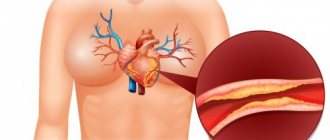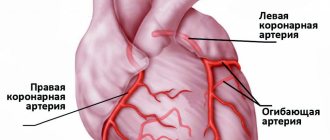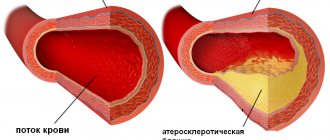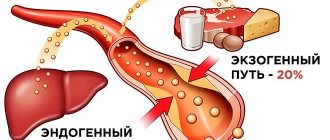Cholesterol is an organic compound found in cell membranes. Necessary for cell construction, synthesis of sex hormones, bile acids, and nutrient metabolism. It plays an important role in the human body, but sometimes causes significant harm.
There are two types of cholesterol in the blood: “good” (HDL) and “bad” (LDL). An increase in the concentration of the latter becomes the main cause of the formation of plaques in blood vessels, resulting in an increased risk of stroke and heart attack. High cholesterol levels are dangerous to health, so they need to be reduced. The most effective methods will be discussed in the article.
What causes cholesterol to rise?
Up to 80% of total cholesterol is synthesized by the human body from fats and only 20% comes to us with food. Moreover, this organic substance is contained exclusively in products of animal origin.
Until recently, it was the abuse of animal fats that was considered the main cause of high cholesterol, but as it turns out, this is not an entirely correct assumption. There are no high or low density lipoproteins in food; they become so during processing in our body. Therefore, metabolic disorders, endocrine diseases, diseases of the liver, intestines and adrenal glands are the main causes of high cholesterol.
At risk of increased LDL and early development of atherosclerosis are:
- patients with diabetes mellitus, obesity;
- people with endocrine diseases, for example, hypothyroidism, deficiency of sex hormones;
- women over 50 years of age, as well as men over 35 years of age;
- people with bad habits;
- patients with diseases of the kidneys, liver, pancreas;
- patients with a hereditary predisposition;
- women who have been taking hormonal medications for a long time.
People at risk should definitely undergo a blood cholesterol test. Because they are susceptible to heart and vascular diseases.
The risk of high blood cholesterol increases with predisposing factors. These include a sedentary lifestyle, bad habits, overeating, an abundance of unhealthy and fatty foods, deficiency of vitamin D, omega-3 polyunsaturated fatty acids in the diet.
High cholesterol in women is more often due to excess weight or low estrogen levels. Typically, this problem occurs during menopause. High cholesterol in men occurs at a younger age, after 35 years. The reason for this is bad habits and poor nutrition.
Symptoms and signs
What symptoms indicate high cholesterol? Unfortunately, it is difficult to detect an increase in cholesterol externally. The main symptoms of the disease include the presence of:
- angina pectoris;
- problems with stool;
- systematic drowsiness;
- fatigue;
- lack of appetite;
- high blood pressure;
- discomfort in the liver area;
- increased nervousness;
- frequent migraines and headaches;
- heart pain;
- pain in the lower extremities when moving;
- xanthoma (fat accumulations under the skin).
If cholesterol increases, you should completely reconsider your lifestyle and diet.
Most often, xanthomas are located in the eyelid area. Other symptoms may also indicate the development of other pathologies. The appearance of early gray hair in men is also a symptom of high cholesterol in the blood.
Gray hair appears due to atherosclerotic changes in the capillaries of the hair follicles. Therefore, if gray hair is observed on the head of a young man, this should be a reason to have his cholesterol levels checked.
Normal cholesterol levels
On average, a healthy person contains about 2 g of cholesterol per 1 kg of body weight. If we talk about laboratory standards, then this is 3.6-7.8 mmol/l. However, when deciphering the results, it is important to understand what kind of cholesterol we are talking about. There are the following varieties:
- HDL – high-density lipoproteins, “good” cholesterol, which utilizes excess “bad” cholesterol;
- LDL - low-density lipoproteins, the main carriers of cholesterol in the blood, have a second name - “bad” cholesterol;
- VLDL are very low density lipoproteins that transport endogenous lipids.
A high level of the last two types is a predisposing factor for the development of atherosclerosis.
What cholesterol is considered high? Any (general, “good” or “bad”), if its concentration is above 5 mmol/l. If previously there were no limits for HDL, now scientists have come to the conclusion that its optimal level for men is 1.9 mmol/l, for women – 2.4 mmol/l. It is important that its concentration does not fall below 1.5 mmol/l, as this will cause an increase in LDL cholesterol.
If the level of “bad” cholesterol is within 5-6 mmol/l, then it is moderately elevated. If it reaches 7 mmol/l or more, it is life-threatening.
Studies have confirmed that extremely high cholesterol in men increases the risk of premature death by 106%. For women, this figure will be 68%. But the situation is no better in the case of extremely low HDL levels. An excessive decrease in “good” cholesterol also adversely affects health and increases the likelihood of early mortality.
New cholesterol controversy
When do you really need to lower cholesterol and who can live long with high levels? The material about this, prepared by KP, was among the top most read on the newspaper’s website.
Dossier "KP"
Philip Kopylov is a professor at the Department of Preventive and Emergency Cardiology, Director of the Institute of Personalized Medicine at Sechenov University, Doctor of Medical Sciences, researcher, cardiologist.
THE MAIN CHALLENGE FOR DOCTORS
Recently, an international group of cardiologists from Sweden, Italy, France, Japan and other countries made a revolutionary statement: there is no evidence to conclusively support the connection between high levels of “bad” cholesterol and cardiovascular disease. The researchers came to this conclusion after studying data from 1.3 million patients. Their health status was monitored for a total of about 50 years. Even more surprising, according to cardiologists, was that older people with high levels of low-density lipoproteins (the same “bad” cholesterol) live on average longer than others! How is this possible? Does this mean that scrambled eggs, butter and fatty meats have been finally rehabilitated, and doctors need to reconsider their approaches to treating heart patients with statin drugs?
“There may be two people standing in front of us, both of them have high cholesterol, only one needs to be treated, and the second can be left alone,” says Philip Kopylov. - Essentially, this is a solution-explanation of the results of a study on the role of cholesterol, which surprised many. The secret is that monitoring people from different risk groups gives different results. And medications act in different ways: if you give them to a sick person according to medical indications, his condition will improve. But if you feed someone who is healthy or who is not so sick that they really need serious medications, then there will be no improvement. The main task, I would even say a challenge, for modern doctors is to determine those who really need to lower cholesterol and when such patients really need statins. Because other people can live longer without treatment, including those with relatively high levels of “bad” cholesterol.
CHECK YOURSELF
What is your risk of cardiovascular disease?
A person is at low risk if they:
a) no high blood pressure. That is, the pressure is not higher than 130/80 mm Hg. Art. under the age of 65 and not higher than 140/80 after 65 years;
b) no excess weight. That is, the body mass index is not higher than 29 (we talked about how to calculate it in the first part of the publication);
c) no diabetes;
d) no atherosclerosis.
- Under such conditions, the patient usually does not need to be treated even if the level of “bad” cholesterol is elevated. That is, if the level of LDL (low-density lipoprotein) in the blood is up to 4.9 mmol/l, explains Philip Kopylov.
If a person is at high risk of cardiovascular disease, including a high risk of heart attack and stroke, then the cholesterol level should be no more than 2.6 mmol/l. And at a very high risk - a maximum of 1.8 mmol/l . If the indicators are higher, they need to be reduced, including with the help of medications.
into the high and very high risk group (depending on the number of risk factors and the degree of neglect) if:
1) is obese. The most dangerous thing is abdominal, that is, in the abdomen. Measure your waist width: for men the critical mark is 102 cm and more, for women – 88 cm and more;
2) high blood pressure (see point “a” above);
3) there is a diagnosis of diabetes mellitus (as a general rule, it is made when the blood sugar level is above 6.7 mmol/l on an empty stomach);
4) the patient abuses salt - exceeds the norm of 5 mg per day, including salt in all dishes and products;
5) overindulges in alcohol. Let us remind you that, according to the latest data, up to 14 servings of alcohol per week for men and up to 8 servings for women are considered relatively safe for health (how much this will be in different types of drinks - see the “Health” section on kp.ru);
6) male gender - the risk of cardiovascular diseases in men is a priori higher;
7) age - for women over 50 - 55 years old; for men - from 45 years old, and if the above factors are present - then starting from 35 years old.
CHOLESTEROL PLAQUE DIFFERENCES PLAQUE
- If I am not in a high or even medium risk group, does this mean that I can unlimitedly eat foods with animal fats - butter, fatty meat, etc.?
— The question is not easy. When we begin to lean on foods rich in animal fats, with a modern sedentary lifestyle, this often results in obesity. You receive at least one risk factor and move from a more “favorable” group to a less favorable one, with a higher risk. And in general, we must admit: the regulation of the system of production and metabolism of cholesterol in the body still partially remains a mystery to scientists. We don't know everything about her.
— Is it undeniable that cholesterol plaques in blood vessels are harmful and dangerous? Or do you also have doubts?
— In humans, already from adolescence, damage to the internal lining of blood vessels begins. And atherosclerotic plaques develop with age in the vast majority of people (essentially, such plaques are accumulations of cholesterol deposits in places of vascular damage. - Author) . However, the problem is that plaques are not all the same. They can be of two types: stable and unstable. And the most serious challenge in cardiology now is to learn to identify and calculate unstable plaques.
- What is their danger?
- At least half of myocardial infarctions occur due to plaques that do not narrow the lumen in the blood vessels or narrow it less than 50%. Such plaques have a thin covering film and a liquid core, where inflammation constantly occurs. Eventually the tire simply breaks. A blood clot forms at this site and blocks the lumen of the vessel. And everything downstream of the blood begins to die.
TO EXERCISE OR NOT TO EXERCISE?
- It is often said that aerobic exercise - brisk walking, running, swimming, ice skating - is useful for increasing blood circulation. And if the plaques are unstable, then it turns out that increased blood flow can worsen the situation?
— Purely theoretically, yes. However, if these loads are regular and reasonable (see below for the “golden” formula for calculating heart rate. - Author) , then they will have a positive effect. Weight and blood pressure will decrease. Also, as a rule, there is a decrease in cholesterol. That is, risk factors are eliminated, and due to this, competent physical exercise brings undeniable benefits. And if you exercise from time to time, and even try to set an Olympic record in the rare moments of your appearance at the gym, then the threat of rupture of plaques and a heart attack really increases significantly.
ON A NOTE
How to determine safe exercise intensity
Use the “golden formula” for calculating your optimal heart rate: 220 minus your age. the resulting figure by 65% - this is the pulse at a moderate load; multiply by 80% - heart rate during intense physical activity. If it is higher, there is already an excessive load, unfavorable for the blood vessels and heart.
QUESTION: WHO NEEDS STATINS?
— Philip Yuryevich, what about statins? Recently, there has been heated debate; the authors of an international study claim that the benefits of such drugs are very doubtful. To whom and why should they be prescribed from your point of view - as a researcher and cardiologist?
- Let's remember: cholesterol enters our body not only with food, 60 - 70% of it is produced in the liver, even if you are on a lean diet. The effect of statins is, on the one hand, to inhibit the production of cholesterol in the liver. At the same time, a mechanism is launched that turns existing unstable plaques into stable ones. And this actually cuts the risk of heart attacks in half.
— It turns out that if a person’s plaques are stable and do not block the lumen of blood vessels, then there are no indications for taking statins? After all, these drugs have serious side effects - from muscle and joint pain to increased blood sugar. When the task is to protect against a real threat, a fatal heart attack, then such “costs” are the lesser of the evils. Are there any current developments to determine the type of plaque in a particular patient?
— There is an intravascular method, when we insert a special sensor into the vessel and use ultrasound or optical coherence tomography to determine the structure of the plaque.
- Do you need to check every plaque?
- Yes. And the sensor, unfortunately, is expensive. Another approach is computed tomography. We put the patient in a computer scanner and do an X-ray examination with contrast of the heart vessels. The resolution of computed tomographs today makes it possible to determine what kind of plaque it is - stable or unstable.
The third approach is a blood test. Now it is actively developing. Very interesting research work is being carried out on microRNAs, that is, small molecules that are responsible for inflammation and the development of atherosclerosis. Based on their presence, concentration and combination, they are trying to build diagnostic systems to identify unstable plaques.
— Are any of these methods used in Russia?
- So far - on a minimal scale, only in large cardio centers, and then as research work for the most part. In general, the problem of determining the type of plaques is solved in different ways throughout the world. The latest international recommendations propose the introduction of computed tomography with contrast as a method of primary diagnosis.
CONGRATULATIONS!
“Sechenovka” has an anniversary!
In 2021, Sechenov University, First Honey, the legendary “Sechenovka”, as it is often called among the people, turns 260 years old. Over these centuries, they worked, taught, treated, created breakthrough methods for saving people here, and most Russian medical luminaries continue to do so. Among the stars of the university is the founder of the school of military field medicine, Nikolai Pirogov ; famous surgeon, professor Nikolai Sklifosofsky ; the founder of Russian forensic psychiatry Vladimir Serbsky ; founder of the medical examination system Nikolai Semashko ; founder of neurosurgery Nikolai Burdenko; founder of the school of cardiovascular surgery Alexander Bakulev . Now among the professors at Sechenovka are academician Leo Bockeria , the chief transplantologist of the Russian Ministry of Health, academician Sergei Gauthier , one of the leading Russian oncological surgeons, an expert on head and neck tumors, academician Igor Reshetov , and many others.
«
Komsomolskaya Pravda" congratulates Sechenov University and wishes new scientific and medical breakthroughs!
Link to publication:
Complications from high cholesterol
High cholesterol is dangerous because it increases the likelihood of developing the following diseases:
- atherosclerosis – accompanied by the formation of atherosclerotic plaques, decreased elasticity of vessel walls, and narrowing of the arteries;
- coronary heart disease – accompanied by narrowing of the coronary artery, which causes myocardial hypoxia and disrupts its functioning;
- hypertension - manifests itself as high blood pressure, against the background of which stroke, heart attack, heart failure and other serious complications are likely;
- stroke - an acute disorder of cerebral circulation as a result of blockage or rupture of a cerebral vessel;
- heart attack – death of a section of the heart muscle due to loss of blood supply.
Most of these diseases are known to be fatal.
High cholesterol at a young age causes early disability and mortality. Due to the increased concentration of LDL, the walls of blood vessels become less elastic, atherosclerotic plaques are deposited on them, which impede blood flow. As a result, blood clots form, which cause heart attack and stroke.
Signs of High Cholesterol:
- heart pain, angina attacks;
- heaviness, pain in the legs even after minor physical exertion;
- the appearance of blood clots with mild bleeding;
- yellow spots on the skin, mainly in the eye area, wen.
More severe symptoms of high cholesterol in men and women appear when LDL levels are at critical levels. This may be a pre-stroke or pre-infarction condition.
The earlier high cholesterol and its causes are identified, the more effective the treatment.
What is good and bad cholesterol
In tissues and blood, cholesterol forms special complexes with groups of lipoprotein proteins. They ensure its stable suspended state. Some of them have high density, others low. These properties of lipoproteins determine the types of cholesterol:
- “good”: HDL, protects cells from damage, ensures normal blood flow and vascular elasticity;
- “bad”: LDL, prone to precipitation, forming atherosclerotic plaques.
It is low-density cholesterol that is meant when they talk about its harm to health. This is true, since its excess is directly related to cardiovascular diseases, diabetes, poor circulation and the risk of strokes. LDL promotes the accumulation of triglycerides - simple fatty acids, overloads the liver, and contributes to the development of gallstones. High-density cholesterol inhibits these pathological processes and partially neutralizes the effect of the “bad”.
How to treat high cholesterol
To reduce LDL levels, it is important to address the cause of high cholesterol and any predisposing factors. First, you should do a lipid profile. The examination shows how serious the increase is . High cholesterol is treated by a general practitioner or cardiologist. There is also a more specialized specialist - a lipidologist.
To reduce high cholesterol levels in the body, you must adhere to the following recommendations:
- Follow a diet. Namely, reduce the consumption of animal fats, “fast” carbohydrates, and foods with trans fats. Nutritional correction reduces LDL levels by 10-15%.
- To refuse from bad habits. Moreover, not only active smoking, but also passive smoking is detrimental to health.
- To live an active lifestyle. It is useful to walk in the fresh air and set aside time for physical exercise. Exercise for at least 30-60 minutes. in a day.
- Control your weight. Fat deposits in the abdominal area are especially dangerous.
- Control blood sugar levels. This recommendation applies to patients with diabetes, as well as people who are predisposed to this disease.
- Cure endocrine diseases, normalize hormonal levels.
Sometimes statins are needed to treat high cholesterol. They produce an immediate effect, but scientists are increasingly talking about their shortcomings. Drugs in this group do not have a selective effect, they reduce everything - both “bad” and “good” cholesterol, and also negatively affect the functioning of the liver. However, their harm is less than the complications of critically high LDL levels.
Diet for high cholesterol
If cholesterol increases, experts recommend reducing the total calorie content of the daily diet, namely: minimizing animal fats in the diet. Meat dishes are replaced with fish, and animal fat with vegetable fat, and include fresh vegetables and fruits in the menu. It is advisable to give preference to seasonal fruits.
You should have breakfast with buckwheat, rice or oatmeal, exclude fatty and fried foods from your diet, which will make it possible to lower LDL (low-density lipoproteins), limit the use of salt and sugar, diversify the menu with foods high in fiber, and exclude fast foods containing saturated and trans fats.
You only need to cook food by steaming it, baking it in the oven or stewing it. Meals should be fractional. This is an important condition for therapy. The diet helps cleanse blood vessels and reduce bad cholesterol levels. Experts advise eating:
- pasta made from durum wheat, baked goods made from wholemeal flour;
- chicken fillet, rabbit, turkey, veal;
- sunflower and olive oil;
- sea fish, oysters and scallops;
- eggs, skim milk, curd mass, yogurt and low-fat kefir;
- low-fat cheeses;
- vegetable soups;
- fish soups;
- fresh vegetable and fruit slices;
- legumes;
- fruit ice cream;
- low-fat pudding, oatmeal cookies and nuts;
- water, fruit drink, freshly squeezed juices without sugar.
If cholesterol increases, you should avoid consuming foods that increase the substance:
- lard, lard, butter and palm oil;
- muffins, pasta made from soft wheat;
- duck, goose and pork meat, which can quickly increase the level of an organic fat-like compound in the blood;
- offal, sausages and pates;
- fried fish, squid, caviar, octopus, shrimp;
- scrambled eggs, sour cream, cream, condensed milk, processed cheese;
- meat broths;
- creams, fatty ice cream, coconuts;
- cocoa and coffee drinks with added cream;
- mayonnaise and fatty sauces.
Treatment of high blood cholesterol levels without diet is ineffective
Products that need to be limited
I would like to say right away that it is impossible to recover with diet alone. Treatment for high cholesterol is complex. However, some dietary restrictions are simply necessary.
If your LDL level is high, limit your consumption of the following foods:
- meat - beef, veal, lamb, pork;
- bird – duck, goose;
- lard, animal by-products;
- sausages, smoked meats;
- canned food;
- high fat dairy products;
- seafood - caviar, shrimp, oysters;
- margarine, mayonnaise;
- chicken yolk;
- coffee;
- sugar, flour products;
- fast food, convenience foods, chips, crackers and other unhealthy foods;
- salt (it prevents the breakdown of fats).
The consumption of fried foods is also limited, but it is impossible to completely remove all animal fats from the diet. If the body feels a lack of cholesterol coming from outside, it will increase its synthesis. When planning a diet, it is important to consult a nutritionist.
Why do you need to lower cholesterol?
Reducing cholesterol levels is necessary to prevent diseases that can be caused by its excess. Such diseases include:
- atherosclerosis, in which the lumens of the arteries narrow or become blocked;
- coronary heart disease;
- myocardial infarction - death of the heart muscle, provoked by the fact that a coronary artery thrombus blocked the access of blood and oxygen;
- angina - insufficient blood supply to the heart muscle with discomfort or pain in the chest;
- strokes caused by the death of brain cells due to blockage of blood vessels by a blood clot and interruption of oxygen supply.
How to lower cholesterol with medications
If the patient follows the recommendations given above, but cholesterol does not decrease, the doctor prescribes medication. It includes:
Statins . The substances block the liver enzyme that produces cholesterol. After taking them, new portions of cholesterol do not enter the blood, and the already accumulated cholesterol is gradually eliminated.
Niacin . Vitamin B blocks the release of fats from fiber into the blood and suppresses the production of cholesterol in the liver. Due to this, its level in the vessels decreases.
Bile acid sequestrants . They bind bile acids in the liver and remove them. Bile acids are produced during the metabolism of cholesterol and fats; when they are removed from the body, cholesterol drops.
All medications have contraindications. Self-selecting and taking medications can have negative health consequences. Before use, consult a cardiologist.
Doctors at the Medicenter clinic network will prescribe a biochemical blood test to determine your cholesterol level. Patients with elevated levels will receive individual recommendations on how to lower cholesterol, taking into account lifestyle, predisposition and health status.






